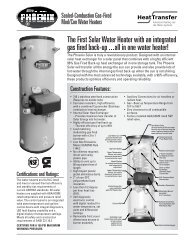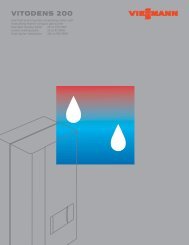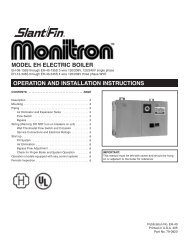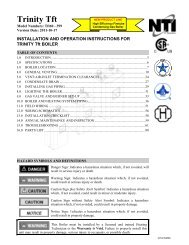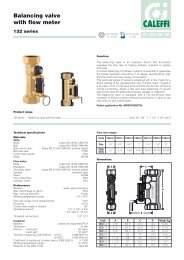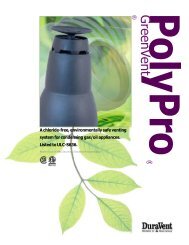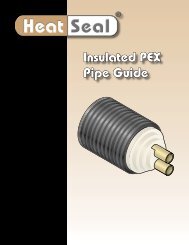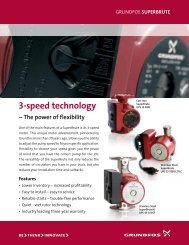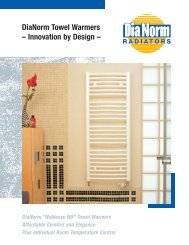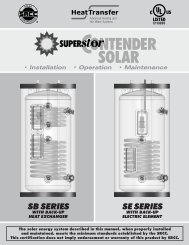Apricus Solar Water Heating System Installation and Operation ...
Apricus Solar Water Heating System Installation and Operation ...
Apricus Solar Water Heating System Installation and Operation ...
Create successful ePaper yourself
Turn your PDF publications into a flip-book with our unique Google optimized e-Paper software.
<strong>Apricus</strong> <strong>Solar</strong> Collector <strong>Installation</strong> & <strong>Operation</strong> Manual - USAProduct Name: DOWFROST* Heat Transfer Fluid Issue Date: 11/05/2007Personal Precautions: Use appropriate safety equipment. For additional information, refer to Section8, Exposure Controls <strong>and</strong> Personal Protection.Environmental Precautions: Prevent from entering into soil, ditches, sewers, waterways <strong>and</strong>/orgroundwater. See Section 12, Ecological Information.7. H<strong>and</strong>ling <strong>and</strong> StorageH<strong>and</strong>lingGeneral H<strong>and</strong>ling: No special precautions required. Keep container closed. Spills of these organicmaterials on hot fibrous insulations may lead to lowering of the autoignition temperatures possiblyresulting in spontaneous combustion. See Section 8, EXPOSURE CONTROLS AND PERSONALPROTECTION.StorageDo not store in: Galvanized steel. Opened or unlabeled containers. Store in original unopenedcontainer. See Section 10 for more specific information. Additional storage <strong>and</strong> h<strong>and</strong>ling informationon this product may be obtained by calling your Dow sales or customer service contact.8. Exposure Controls / Personal ProtectionExposure LimitsComponent List Type Value|Propylene glycol WEEL TWA 10 mg/m3Aerosol.|Personal ProtectionEye/Face Protection: Use safety glasses.Skin Protection: Wear clean, body-covering clothing.H<strong>and</strong> protection: Use gloves chemically resistant to this material when prolonged orfrequently repeated contact could occur. Examples of preferred glove barrier materialsinclude: Butyl rubber. Natural rubber ("latex"). Neoprene. Nitrile/butadiene rubber ("nitrile" or"NBR"). Polyethylene. Ethyl vinyl alcohol laminate ("EVAL"). Polyvinyl alcohol ("PVA").Polyvinyl chloride ("PVC" or "vinyl"). NOTICE: The selection of a specific glove for a particularapplication <strong>and</strong> duration of use in a workplace should also take into account all relevantworkplace factors such as, but not limited to: Other chemicals which may be h<strong>and</strong>led, physicalrequirements (cut/puncture protection, dexterity, thermal protection), potential body reactionsto glove materials, as well as the instructions/specifications provided by the glove supplier.Respiratory Protection: Respiratory protection should be worn when there is a potential to exceedthe exposure limit requirements or guidelines. If there are no applicable exposure limit requirementsor guidelines, wear respiratory protection when adverse effects, such as respiratory irritation ordiscomfort have been experienced, or where indicated by your risk assessment process. In mistyatmospheres, use an approved particulate respirator. The following should be effective types of airpurifyingrespirators: Organic vapor cartridge with a particulate pre-filter.Ingestion: Use good personal hygiene. Do not consume or store food in the work area. Wash h<strong>and</strong>sbefore smoking or eating.Engineering ControlsVentilation: Use local exhaust ventilation, or other engineering controls to maintain airborne levelsbelow exposure limit requirements or guidelines. If there are no applicable exposure limitrequirements or guidelines, general ventilation should be sufficient for most operations. Local exhaustventilation may be necessary for some operations.Page 3 of 7Copyright 2011 – <strong>Apricus</strong> Inc Doc: A7-05.4.1.4-PB-1.9 Page 110 of 126



